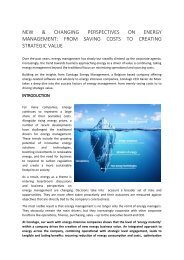Accurate Allocation of energy in production processes - the importance of using metamodels
Many companies struggle with correctly monitoring, allocating and distributing direct and indirect energy consumption over all internal and external customers, users or products. In this age of rising commodity costs and additional attention to sustainability, the advantages of adequately allocating energy are nonetheless substantial: 1. Real-time mapping of energy throughout process flows makes it easier to detect deviations in energy conversions during production processes, find the root causes and reduce losses. 2. Using exact and objective keys for allocating energy consumption speeds up periodic P&L and CSR reporting and makes for more accurate reports. 3. Continuous, real-time distribution of energy cost among users increases transparency and raises awareness with them. Although most companies already struggle with integrating correct data from metered equipment, this is only the first - albeit important - step. The crux is fully understanding the nature and efficiency of energy conversions processes; energy inflows and outflows to different customers; fixed and variable costs and corporate structures. By using metamodels - designed for and maintained by energy managers - all this information is added to the initial metered data and processed in such a way that any change from an energy point of view instantly leads to adjustments in the energy allocation. This white paper reviews emerging trends and challenges in energy allocation and examines the working and benefits of using specific metamodels at the level of energy management software.
Many companies struggle with correctly monitoring, allocating and distributing
direct and indirect energy consumption over all internal and external customers,
users or products. In this age of rising commodity costs and additional
attention to sustainability, the advantages of adequately allocating energy are
nonetheless substantial:
1. Real-time mapping of energy throughout process flows makes it easier
to detect deviations in energy conversions during production processes,
find the root causes and reduce losses.
2. Using exact and objective keys for allocating energy consumption
speeds up periodic P&L and CSR reporting and makes for more accurate
reports.
3. Continuous, real-time distribution of energy cost among users increases
transparency and raises awareness with them.
Although most companies already struggle with integrating correct data from
metered equipment, this is only the first - albeit important - step. The crux is
fully understanding the nature and efficiency of energy conversions processes;
energy inflows and outflows to different customers; fixed and variable costs
and corporate structures. By using metamodels - designed for and maintained
by energy managers - all this information is added to the initial metered data
and processed in such a way that any change from an energy point of view
instantly leads to adjustments in the energy allocation.
This white paper reviews emerging trends and challenges in energy allocation
and examines the working and benefits of using specific metamodels at the
level of energy management software.
You also want an ePaper? Increase the reach of your titles
YUMPU automatically turns print PDFs into web optimized ePapers that Google loves.
What exactly are <strong>metamodels</strong>?<br />
‘To measure is to know’, is <strong>the</strong> adagio at <strong>the</strong> heart <strong>of</strong> <strong>energy</strong> management.<br />
Systematically collect<strong>in</strong>g <strong>the</strong> read<strong>in</strong>gs from a network <strong>of</strong> (sub)meters is <strong>in</strong>deed<br />
<strong>the</strong> start<strong>in</strong>g po<strong>in</strong>t. The boom <strong>in</strong> submeter<strong>in</strong>g <strong>of</strong> <strong>the</strong> last decade brought with<br />
it a proliferation <strong>of</strong> s<strong>of</strong>tware packages focused on collect<strong>in</strong>g, validat<strong>in</strong>g and<br />
visualis<strong>in</strong>g <strong>in</strong>formation. At <strong>the</strong> time <strong>of</strong> writ<strong>in</strong>g this document, Capterra lists<br />
156 applications under <strong>the</strong> head<strong>in</strong>g ‘<strong>energy</strong> management’. If we add generic<br />
enterprise data management s<strong>of</strong>tware be<strong>in</strong>g used for stor<strong>in</strong>g metered data <strong>the</strong><br />
tally goes up even more.<br />
Data management is important, but only a first step. Data needs to be <strong>in</strong>terpreted<br />
with<strong>in</strong> <strong>the</strong> specific structure <strong>of</strong> <strong>the</strong> company to really build understand<strong>in</strong>g <strong>of</strong><br />
<strong>the</strong> <strong>energy</strong> situation. Identify<strong>in</strong>g <strong>the</strong> real cost drivers or <strong>the</strong> most attractive<br />
improvement projects, follow<strong>in</strong>g up on performance - or assign<strong>in</strong>g <strong>energy</strong> to<br />
<strong>in</strong>ternal users - can only be done when <strong>the</strong>re is more <strong>in</strong>fo on <strong>the</strong> context. For<br />
each measured value, <strong>the</strong>re needs to be <strong>in</strong>formation on where and when it was<br />
recorded, what k<strong>in</strong>d <strong>of</strong> process/build<strong>in</strong>g <strong>the</strong> meter is associated with, what<br />
k<strong>in</strong>d <strong>of</strong> <strong>energy</strong> flow is be<strong>in</strong>g measured and how it is related to o<strong>the</strong>r meters<br />
and flows. Such ‘data on <strong>the</strong> data’ are what is called metadata. A structured<br />
overview <strong>of</strong> all relevant metadata and <strong>the</strong> relationships between <strong>the</strong>m, is what<br />
is called a meta-model.<br />
Most <strong>energy</strong> management s<strong>of</strong>tware is not built around <strong>metamodels</strong> and<br />
is <strong>the</strong>refore limited to record<strong>in</strong>g and visualis<strong>in</strong>g metered values, leav<strong>in</strong>g<br />
<strong>in</strong>terpretation entirely to <strong>the</strong> user/<strong>energy</strong> manager. A limited number <strong>of</strong><br />
programs -as mentioned before - do <strong>in</strong>corporate some k<strong>in</strong>d <strong>of</strong> model and<br />
allow for <strong>energy</strong> reports that are organisation-specific and <strong>in</strong>fused with<br />
mean<strong>in</strong>g. Typical examples <strong>in</strong>clude <strong>the</strong> monitor<strong>in</strong>g <strong>of</strong> <strong>the</strong> consumption <strong>of</strong> an<br />
entire build<strong>in</strong>g based on <strong>the</strong> read<strong>in</strong>gs <strong>of</strong> several submeters or <strong>the</strong> report<strong>in</strong>g on<br />
(variable) <strong>energy</strong> costs <strong>of</strong> an entire department.<br />
The core elements <strong>of</strong> <strong>metamodels</strong><br />
Complete <strong>metamodels</strong> for <strong>energy</strong> management conta<strong>in</strong> three basic categories<br />
<strong>of</strong> <strong>in</strong>formation.<br />
Structure <strong>of</strong> <strong>energy</strong> flows<br />
Every <strong>production</strong> process consists <strong>of</strong> a number <strong>of</strong> conversions, which toge<strong>the</strong>r<br />
transform flows <strong>of</strong> raw material <strong>in</strong>to a (semi-)f<strong>in</strong>ished product. This is reflected<br />
energetically as well. A number <strong>of</strong> <strong>energy</strong> flows are acquired or produced<br />
9




